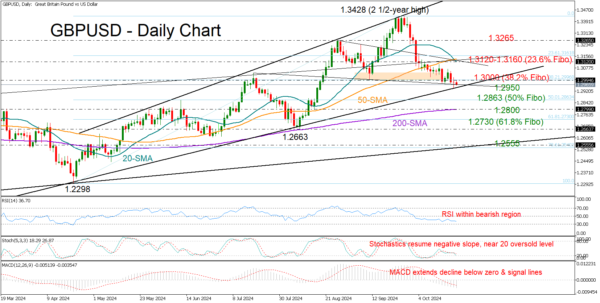- GBPUSD prints new lower low, reaches long-term support trendline
- Technical signals remain discouraging; more sellers wait below 1.2950
GBPUSD is currently in its fourth consecutive week of losses, gradually slipping below the 1.3000 mark for the first time since August. The pair recently hit a new lower low of 1.2943, with technical indicators reflecting persisting selling appetite. However, the long-term support trendline drawn from the 2022 bottom, currently around 1.2950, is providing some protection for the broader uptrend.
A close below the 1.2950 threshold could dampen market sentiment, causing another decline toward the 200-day simple moving average (SMA) at 1.2800, especially if the 50% Fibonacci retracement level from the April-September uptrend at 1.2863 is breached. Additional losses may pause near the 61.8% Fibonacci level at 1.2730 or could even extend toward the August low of 1.2663. If this trend continues, the pair could approach the ascending line connecting the October 2023 lows around 1.2555.
Conversely, if GBPUSD manages to reclaim the 1.3000 level, it could next target the 20- and 50-day SMAs around 1.3120, as well as the 23.6% Fibonacci level at 1.3160. A successful break above these barriers could pick up pace toward August’s high of 1.3265.
In summary, while GBPUSD currently exhibits a bearish bias, the long-term support at 1.2950 could allow for some recovery, keeping traders alert for potential shifts in momentum.










![Week ahead – ECB set to cut, BoC might pause as Trump U-turns on tariffs [Video]](https://www.actionforex.com/wp-content/uploads/2018/04/f-ecb29-218x150.jpg)





